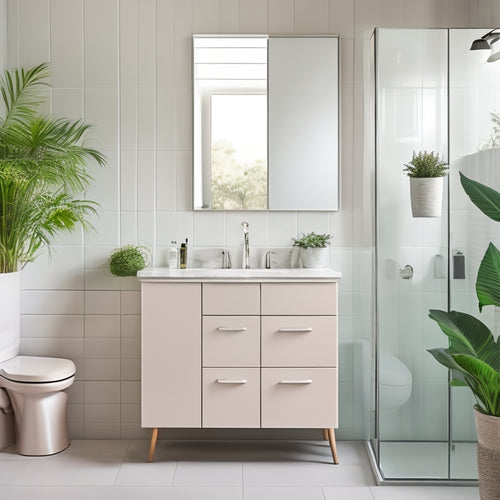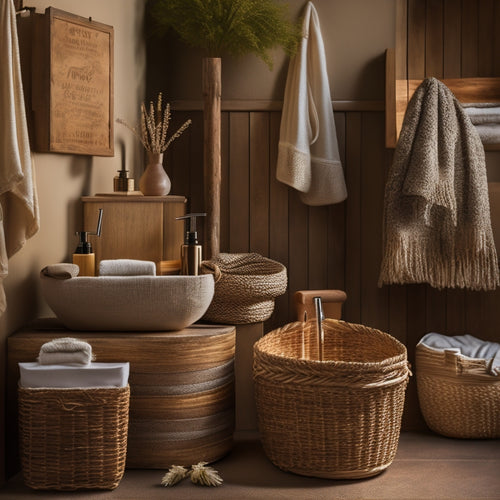
Revamp Your Bathroom With Expert Design Tips
Share
Begin your journey to transform your bathroom into a serene oasis by carefully considering the functional zones, fixtures, and aesthetics that meet your unique needs and style. A well-planned renovation involves dividing the space into zones, selecting fixtures and flooring that balance functionality and style, and incorporating safety features and accessibility into shower design. From freestanding tubs to bespoke sink and fixture choices, every element should harmonize to create a cohesive atmosphere. As you start on this journey, discover the endless possibilities for creating a bathroom that not only reflects your personality but also enhances your daily routine, and explore the art of crafting a space that truly relaxes and inspires.
Key Takeaways
• Divide the bathroom into functional zones to ensure a logical and efficient layout.
• Incorporate shower safety features, such as grab bars and non-slip flooring, for a safe and accessible shower experience.
• Balance functionality, style, and space constraints when selecting a tub, and consider freestanding options for a spa-like experience.
• Choose sink and fixture combinations that consider material, shape, and finish to create a cohesive and functional design.
• Consider sustainable flooring options, such as recycled materials, and incorporate different lighting types to create a unique and eco-friendly atmosphere.
Bathroom Renovation Planning Essentials
When starting a bathroom renovation, it's crucial to consider the number of users and customize the design around their specific needs, guaranteeing a space that is both functional and aesthetically pleasing.
A Bathroom Dream Sheet is a valuable tool for planning, allowing you to outline your must-haves and share them with your renovation team.
Divide the bathroom into functional zones, such as a sink area and toilet zone, to create a smooth shift between spaces. This thoughtful approach guarantees that every element, from fixtures to flooring, is carefully selected to meet the needs of its users.
Shower Design and Accessibility
A well-designed shower area can elevate the overall bathroom experience, and by exploring various shower options, homeowners can create a space that not only meets their functional needs but also reflects their personal style.
When designing a shower, consider the following key elements:
-
Shower safety: Incorporate non-slip flooring, grab bars, and seating to guarantee a safe and accessible showering experience.
-
Accessibility in showers: Opt for universal design features, such as curbless showers, to create a seamless and obstruction-free space.
-
Style and functionality: Choose from a range of showerhead options, including wall-mounted, rain, or handheld showerheads, to create a shower that addresses your needs and aesthetic.
- Personalization: Add personal touches, such as body sprays or a shower bench, to create a truly bespoke shower experience.
Tub Selection and Installation
Selecting the ideal tub for your bathroom oasis involves balancing functionality, personal style, and spatial constraints. The right tub can become a serene focal point, elevating the overall ambiance of the space.
Freestanding tubs, a popular 2020 design trend, offer a luxurious spa-like experience. When choosing a tub, consider the tub apron design, which can be adorned with ornate tiling options, adding visual appeal to the space.
Proper installation is essential to guarantee a seamless look. Additionally, maintenance should be considered, as freestanding tubs require more upkeep than traditional models.
Sink and Fixture Choices Matter
Every sink choice bears the potential to dramatically influence the overall aesthetic and ambiance of the bathroom, making it an important element in the design process that requires careful consideration.
When selecting a sink, consider the following key factors:
-
Sink materials and shapes: Choose from a range of materials, such as ceramic, glass, or solid surface, and shapes, including undermount, topmount, or vessel sinks.
-
Faucet finishes and styles: Select from various finishes, like chrome, bronze, or matte black, and styles, including single-handle, widespread, or wall-mount faucets.
-
Sink size and proportion: Make sure the sink is proportional to the vanity and bathroom size.
- Functionality and features: Take into account features like touchless faucets, built-in soap dispensers, or sinks with built-in counter space.
Flooring, Lighting, and Green Upgrades
As the sink and fixture choices are finalized, attention turns to the often-overlooked yet equally essential elements of bathroom design: the flooring, lighting, and green upgrades that can elevate the space from functional to fabulous.
Flooring options abound, from natural stone to ceramic and porcelain tile, but don't forget to take into account texture for safety and the luxury of heated floors.
Lighting is also vital, with ambient, task, accent, and decorative options available to create a unique atmosphere.
Finally, incorporate sustainable elements, such as energy-efficient appliances and solar panels, to create a truly eco-friendly space. Sustainable lighting options, like LED fixtures, can also reduce your carbon footprint while adding a touch of modern style.
Frequently Asked Questions
How Do I Ensure My Bathroom Renovation Stays Within Budget?
To guarantee a bathroom renovation stays within budget, prioritize budget tracking and cost control by setting realistic financial goals, allocating funds to must-haves, and making conscious design decisions that balance aesthetics with affordability.
Can I DIY Certain Aspects of My Bathroom Renovation?
'A million things can go wrong with DIY bathroom renovations! While some tasks, like tile laying and installing shower panels, can be tackled solo, it's important to assess your skills and leave complex tasks to professionals to avoid costly mistakes.'
What Is the Best Way to Store Toiletries and Bathroom Essentials?
Optimize bathroom storage with shelf organization systems and hidden compartments, such as recessed medicine cabinets, slide-out drawers, and decorative storage units, to keep toiletries and essentials within easy reach while maintaining a clutter-free aesthetic.
Are There Any Bathroom Design Trends That Are Timeless?
Timeless bathroom design trends include incorporating classic accents, such as ornate mirrors and decorative trim, paired with neutral colors, like soft whites and grays, to create a sophisticated and enduring aesthetic that transcends fleeting styles.
How Often Should I Clean and Maintain My Bathroom to Prevent Mold and Mildew?
To prevent mold and mildew, maintain your bathroom by cleaning regularly with natural cleaning products, ensuring proper ventilation systems, and inspecting for moisture buildup, especially in areas around showers, sinks, and toilets.
Related Posts
-

Space-Saving Bathroom Storage With Slimline Cabinets
Slimline cabinets are your perfect solution for space-saving bathroom storage. They employ vertical space effectively...
-

Rustic Bathroom Storage Baskets and Bins
Rustic bathroom storage baskets and bins add both charm and practicality to your space. Made from natural materials l...
-

Dartmouth's Diverse Campus Support Networks Unveiled
Dartmouth College offers a wide-reaching network of support systems and resources, fostering an inclusive environment...


